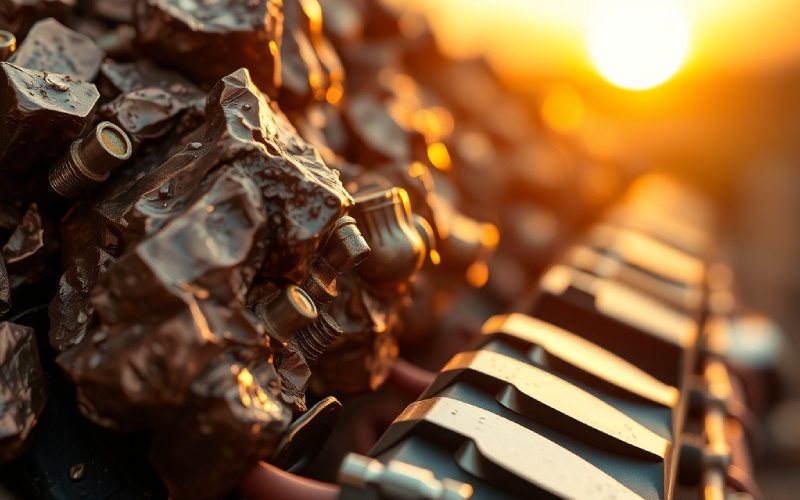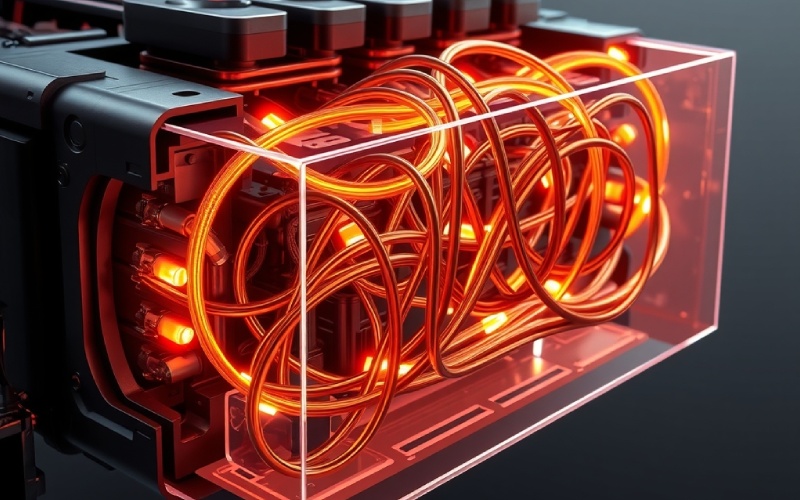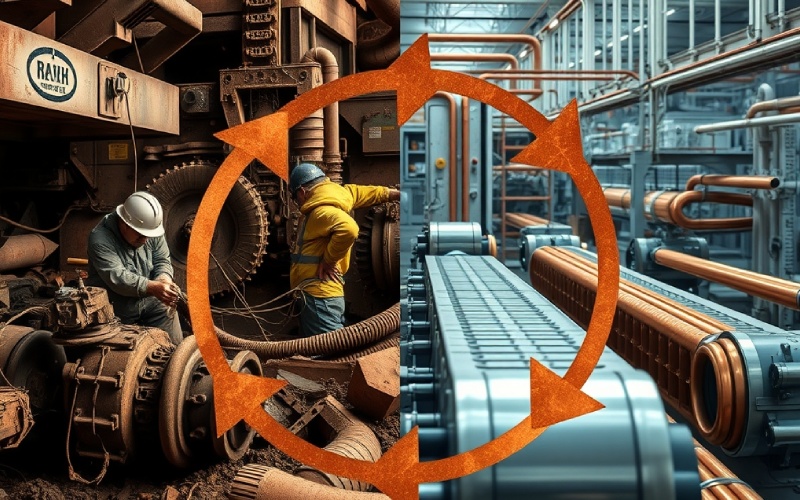Let Istar help you get started on your project with our experience and know-how!
Upload your design files and production requirements and we will get back to you within 30 minutes!

We’ve been utilizing copper for over 10,000 years! From the initial devices that lifted us out of the Stone Age to the complex electronic devices that power our modern-day world, copper has existed every action of the method. In this article, I wish to show you everything you require to find out about this amazing component. We’ll explore its distinct properties, just how we get it out of the ground, and the unbelievable methods we use it everyday. You’ll see why this functional metal is so vital.
Allow’s start with the fundamentals. Copper is a chemical element, much like oxygen or gold. On the periodic table, you’ll discover it with the sign Cu and the atomic number 29. The symbol Cu comes from the Latin word “cuprum,” which implies “from the island of Cyprus,” a significant resource of copper in ancient times. It is just one of the few metals on the periodic table that isn’t normally gray or silver. Instead, pure copper has a beautiful reddish-orange shade.
This outstanding steel is soft, simple to form, and a wonderful conductor of warmth and electrical energy. Actually, its capability to carry out electrical power is 2nd only to silver. This is why you’ll find copper in a lot of electric applications. Copper is a ductile steel, which suggests it can be stretched into a slim copper wire without damaging. This home of ductility is vital for making the cords that power our homes and devices.
Copper is also a hefty steel with a reasonably high density. It’s a vital trace element that all living things need to survive, including us! Our bodies use it to aid develop red cell. You can even locate it in a protein called hemocyanin, which lugs oxygen in the blood of some pets like crawlers and octopuses. This metal is really throughout us and inside of us. It is one of the few steels that can occur in nature in a directly usable, metallic kind, called native copper.
So, where do we get all this beneficial steel? The majority of the world’s copper is secured away in the Planet’s crust in the type of ore. This ore isn’t pure copper; it’s a rock that contains copper minerals. For an ore to be worth mining, it typically requires to have in between 0.5% and 2.0% copper. The most usual kind of copper ore is a sulfide ore, with minerals like chalcopyrite being a significant resource. An additional kind is oxide ore, that includes minerals like azurite and cuprite.
The procedure of obtaining copper begins at a mine. The majority of copper mining today takes place in big open-pit mines, where big equipments dig huge pits in the ground to get to the copper ore. These mines are often enormous, creating terraces that step down right into the planet. The globe’s top manufacturer of copper is Chile, complied with by other nations like Peru and the USA.
When the copper ore is dug up, the journey to get pure copper has simply begun. The rock has to be smashed and processed to separate the useful copper minerals from the waste rock. It’s an intricate process that I’ll dive into even more information on a little later. Finding a great resource of copper is key, and these huge open pit mines are the most significant resource we have. It’s from these modest rocks that we obtain the shiny, versatile metal we rely upon so much.
I have actually constantly located the properties of copper to be fascinating. It’s this one-of-a-kind mix of traits that makes it so useful in many different applications. Let’s break down several of the key physical residential properties and chemical buildings that make this steel attract attention.
Among one of the most widely known properties of copper is its amazing capacity to conduct electrical energy. This high electrical conductivity is why it’s the standard material for electric wiring. Think of it: nearly every electronic gadget you have counts on copper wire to operate. It additionally has high thermal conductivity, implying it’s fantastic at transferring warmth. This makes it perfect for points like copper tubing in ac system and radiators in cars.
Copper is likewise a very pliable steel, which indicates it can be quickly extended right into a cable. Its malleability, or the ability to be inculcated slim sheets, is another key physical residential or commercial property. This combination of ductility and stamina makes it easy to deal with. Additionally, copper has good machinability, particularly when it belongs to an alloy, implying it can be quickly cut and formed by a machine. An additional helpful characteristic is its low thermal growth, implying it doesn’t expand or acquire much with modifications in temperature level.
When it pertains to chemical buildings, copper is quite resistant to rust. When subjected to the air, it gradually creates a safety layer of brown-black copper oxide. This procedure is called passivation. Over a long time, this layer can develop into an environment-friendly patina, which is a layer of copper carbonate. You’ve most likely seen this on old copper roof coverings or the Statue of Freedom, which is covered in a copper finish. This patina actually protects the solid copper below from additional rust.
Below is a table summing up some of the vital properties of copper:
| Residential or commercial property | Description |
|---|---|
| High Electrical Conductivity | Secondly only to silver, making it perfect for wiring. |
| High Thermal Conductivity | Excellent at moving warm, made use of in cooling down systems. |
| Ductility | Can be quickly drawn into slim cables. |
| Pliability | Can be hammered or pressed into slim sheets. |
| Rust Resistance | Types a protective patina in time. |
| Antimicrobial | Normally eliminates microorganisms and infections. |
These one-of-a-kind electric and thermal conductivity buildings are what make copper such an essential steel in our modern-day globe.

Getting pure copper from the planet is a remarkable process that entails a lot of scientific research and engineering. I’ve constantly been astonished by the area of metallurgy and exactly how we can take a rock and turn it into a high-purity steel. The trip from ore to a glossy sheet of copper is a multi-step procedure.
Initially, the copper ore is dug out of the mine. As I discussed, this usually occurs in huge open-pit mines. The ore is after that crushed right into smaller pieces. The next action relies on whether it’s a sulfide ore or an oxide ore. Concerning 80% of the world’s copper originates from sulfide ores. For these ores, a process called froth flotation is made use of. The crushed ore is blended with water and chemicals, and air is gurgled with it. The little copper fragments adhere to the bubbles and drift to the top, where they can be skimmed. This develops a concentrate that has a much higher percent of copper.
Next comes the pyrometallurgy, which entails heat. The concentrate is taken into a heating system to smelt it. To smelt the ore implies to thaw it at a really heat to separate the copper from various other components like iron and sulfur. This process develops a molten blend called matte. The matte is after that put into a converter, where more contaminations are gotten rid of, resulting in what’s called “blister copper,” which has to do with 99% pure.
For the greatest purity, the sore copper goes through a last action called electrorefining. In this procedure, the copper is dissolved in an acidic remedy, and an electric current is made use of to deposit extremely pure copper onto a cathode sheet. The outcome is copper that is 99.99% pure! For oxide ores, a various process called hydrometallurgy is frequently used. This entails making use of liquids to seep the copper out of the ore. A typical method is load leaching, where a sulfuric acid service is trickled over a heap of crushed ore, liquifying the copper. The copper is after that recuperated from the service. Despite the method, the goal is to change that rock from the mine right into the pure steel we require.
One of the important things that makes copper so versatile is its capability to react and develop substances with other components. Pure copper is fantastic, but often a copper compound has the exact properties required for a specific work. In the world of chemistry, copper generally reveals 2 major oxidation states: +1 (cuprous) and +2 (cupric). This simply suggests it can shed 1 or 2 electrons when it forms a chemical bond.
When copper is subjected to the air, it reacts with oxygen to form a thin layer of copper oxide. This is a basic binary compound, meaning it’s made of simply 2 components. The blackish finish that can base on copper is a type of copper oxide (cupric oxide). Over time, and with direct exposure to moisture and co2, this can bring about the development of that acquainted green patina, which is a kind of copper carbonate. You can see this magnificently on the Statuary of Liberty.
Copper can additionally react with sulfur to develop copper sulfide. A number of the copper ores we find in the ground, like chalcopyrite and bornite, are sulfide minerals. Copper likewise reacts with acids. For example, it can dissolve in sulfuric acid in the visibility of oxygen. This reactivity enables us to create a vast array of valuable copper compounds. For instance, copper sulfate is an intense blue crystal that is made use of in agriculture as a fungicide and in swimming pools to manage algae.
The capability of this chemical element to develop such a variety of substances is just one more reason why it’s so crucial in numerous various industries.
As amazing as pure copper is, I believe it gets even much more fascinating when we start blending it with various other metals. When you integrate two or more steels, you develop an alloy. An alloy typically has various, and sometimes much better, residential or commercial properties than the pure metals it’s made from. There more than 400 various copper alloys, each with its own distinct collection of qualities. The development of a copper alloy is an essential part of what makes this metal so beneficial.
The two most popular alloys of copper are bronze and brass. I’ll speak more regarding each of these momentarily, yet they are wonderful examples of exactly how adding another component can completely transform the buildings of the steel. For instance, including tin to copper makes it tougher and extra resistant to use, producing bronze. Adding zinc to copper develops brass, which is understood for its strength and machinability.
Yet the globe of copper alloys goes far beyond just bronze and brass. Below are a couple of other important examples:
By developing an alloy, we can tailor the properties of copper to fit a specific need. We can make it more powerful, harder, or much more resistant to rust. This capacity to create alloys is one of the primary reasons copper is made use of in such a substantial range of applications, from musical instruments to commercial equipment. The versatility of a good copper alloy is hard to defeat.

When you talk about the background of products, you can not disregard bronze. It’s such an essential copper alloy that it has a whole period of human history named after it: the Bronze Age. This was the time when individuals first discovered exactly how to develop this cutting edge steel by deliberately alloying copper with tin. This exploration, which occurred around 3500 BC, changed everything.
So, what made bronze such a big bargain? Pure copper is a fairly soft metal. While you can hammer native copper into shapes, it’s not suitable for making strong tools or tools. By including tin, people created an alloy that was much more difficult and more long lasting than pure copper. Bronze might hold a sharp side for longer, and it was likewise much easier to cast right into complicated shapes in a mold. This was a massive jump ahead in metallurgy.
All of a sudden, people could make far better devices for farming, more powerful weapons for searching and protection, and extra beautiful items for art and religious events. The ability to create bronze offered societies a significant benefit. It brought about breakthroughs in every little thing from farming to war. The expense of copper was reasonably reduced, but tin was much rarer and frequently needed to be traded over fars away, making bronze a beneficial material. The Bronze Age was truly a time when this copper and tin alloy assisted to shape the future of civilization.
After bronze, the next popular copper alloy I have to tell you around is brass. While bronze is typically an alloy of copper and tin, brass is an alloy of copper and zinc. This mix creates a beautiful steel with an intense, gold-like look that has a variety of uses. There are many different types of brass, with differing amounts of copper and zinc, which provides different homes.
Among the vital attributes of brass is its exceptional machinability, which implies it’s extremely simple to reduce and form with a machine. This makes it a fantastic choice for making things like fittings, shutoffs, and equipment. Brass is an alloy that is likewise extremely immune to deterioration and is a good conductor of warm. You’ll typically locate it used in plumbing components and for all-time lows of saucepans.
Like copper, brass has all-natural antimicrobial residential or commercial properties, which suggests it can eliminate microorganisms on its surface area. This is why you commonly see brass doorknobs and hand rails in public buildings– it aids to quit the spread of germs. Another big usage for brass is in musical tools. Trumpets, trombones, and saxophones are all made from brass due to its acoustic properties and the lovely sound it creates. The applications of copper when become brass are genuinely varied.
Past its pure metallic form and its many alloys, copper additionally creates a range of important chemical substances. A copper compound is a compound formed when copper atoms chemically bond with atoms of one or more various other elements. These compounds typically have very various properties from metal copper and are used in a significant series of applications.
As I discussed earlier, copper normally forms substances where it has an oxidation state of +1 (cuprous) or +2 (cupric). The shade and residential properties of the compound commonly rely on this state. As an example, cuprous oxide (Cu ₂ O) is a reddish powder, while cupric oxide (CuO) is a black powder. Both are made use of as pigments in ceramics and glass to develop beautiful colors.
Here are a few of one of the most usual and valuable copper compounds:
The ability to militarize chemical reactions is an additional crucial property of many copper compounds. They can assist quicken chemical procedures, making them important in industrial setups. From protecting our plants to tinting our world, these copper compounds play a vital function in our every day lives.
I locate it amazing that a steel we began making use of hundreds of years earlier is still one of one of the most important products in our sophisticated globe. The applications of copper are everywhere you look. Its special combination of residential or commercial properties makes it crucial in numerous various markets.
The largest use copper, without a doubt, is for electrical applications. As a result of its high electrical conductivity, it’s the ideal product for making copper wire and wires. From the substantial power grids that brighten our cities to the little circuits inside your mobile phone, copper is what makes the flow of power possible. It’s also a key element in electrical motors, transformers, and generators.
Right here’s a fast run-through of several of the significant ways we utilize copper today:
The checklist goes on and on. We utilize copper in whatever from cookware and musical tools to solar panels and wind turbines. It’s a testimony to the amazing versatility of this steel. As we relocate towards a much more electrical and sustainable future, the need for copper is only going to grow.